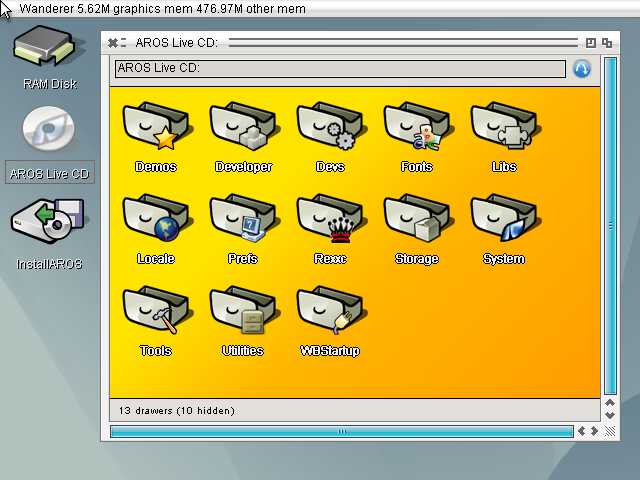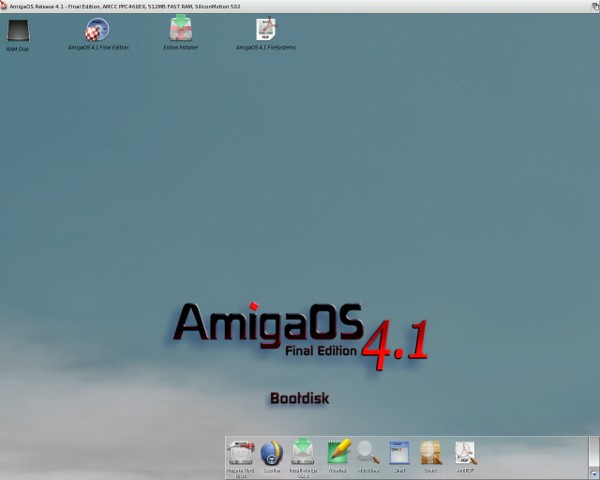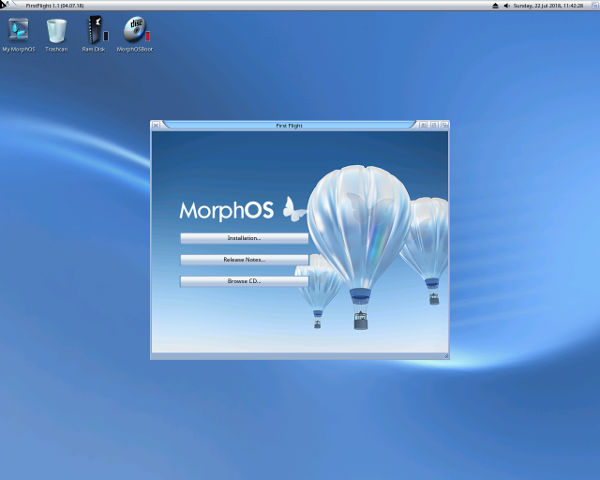Previously no donations were accepted and they are still not solicited but to
respond to "popular demand" (i.e. a few people asked) now there is a way to
Unless another version is listed, this needs at least QEMU 3.0 and does not work with
older versions but you ought to use at least QEMU 8.0 and using the latest QEMU version
is recommended. Pre-compiled binaries are available from
QEMU downloads or you can try binaries
provided by Emaculation.com
The
sam440-ppc-boot-iso from the
AROS Nightly Build Downloads (ABI-v1) page should boot and mostly work but it's
not well tested on real hardware so when a problem is found I'm not sure what is an
AROS bug or an emulation bug. Start it as:
qemu-system-ppc -machine sam460ex -serial stdio -rtc base=localtime \
-drive if=none,id=cd,format=raw,file=aros-sam440-ppc.iso \
-device ide-cd,drive=cd,bus=ide.1
Minimum required QEMU version: v2.12.0.
Known problems
- Screen is 640x480 and no other modes are available. (This is
probably because AROS does not support EDID in SM502 graphics driver,
this should be implemented in AROS.)
- Sometimes seems to hang during boot at a grey screen. (This may be a race
condition in AROS, booting again helps.) The slowness during boot is
because the low level i2c driver accessing RTC which could be improved
writing a better AROS driver.
- Only the
-device ne2k_pci network card emulation seems to
work with the prm-rtl8029.device AROS driver. Other cards don't
seem to work but not sure if it's AROS driver or QEMU problem but
since other OSes work I think those AROS drivers are x86 only and
don't work on big endian machine like PPC so this should be fixed in AROS.
AmigaOS has different versions that come with kernel and drivers for the supported
machine only, so the appropriate version matching the emulated hardware is needed.
Currently these are
amigaone (since QEMU v8.2.0),
pegasos2
(since QEMU v6.1.0) and
sam460ex (since QEMU v3.0.0). The
sam460ex is easiest to boot as the firmware is included in QEMU and
Sam460 install CD comes with the required graphics driver but it runs slower so other
machines are preferred.
AmigaOS on sam460ex with QEMU v9.0.0 and newer can be started as:
qemu-system-ppc -machine sam460ex -rtc base=localtime -cdrom Sam460InstallCD-53.58.iso
Older QEMU versions not supporting
-cdrom option with
sam460ex need to use the more verbose
-drive if=none,id=cd,format=raw,file=Sam460InstallCD-53.58.iso -device ide-cd,drive=cd,bus=ide.1
syntax instead.
See separate page describing the easiest way to install AmigaOS
using BBoot for running the AmigaOne SE/XE/microA1 or PegasosII versions of AmigaOS
on these machines.
The pegasos2 machine
was added in QEMU v6.1.0
but needed some fixes to run the appropriate PegasosII version of AmigaOS that was
first available in QEMU v8.0.0 but installing AmigaOS was not easy at first. This is
documented on a
historic page on installing AmigaOS 4.1 on pegasos2
that is now replaced by the simpler BBoot method above. From QEMU v8.2.0 there is also
amigaone machine which shares most components with pegasos2
as these two machines are very similar but the AmigaOne version of AmigaOS has less bugs
and those who only have this AmigaOS version can now also use it with QEMU. The
amigaone machine was improved in QEMU v10.0.0 so that or newer version is
recommended for using it.
Known problems
- Disk fills up quickly during install
You may have too big block size set for the file system. This can be changed
during partitioning in "select filesystem / edit defaults". Not sure why it
seems to default to a large value such as 32k (maybe it depends on partition
size) but if you expect to write many small files 1k or 512 bytes block size
will use less space but may be slower. Something between 1k and 4k may
be a good value depending on expected partition usage for FFS and 512
bytes for SFS.
- Graphics glitches on Apple silicon macOS with older QEMU
There is an issue with pixman library on 64 bit ARM such as Apple silicon Macs
running macOS which is "solved" in brew by just disabling the parts that don't
compile. This causes missing graphics elements with sm501 and
ati-vga. You either need to compile pixman with
some patches
or use at least QEMU 8.0 which has fall backs for this case for sm501. For
ati-vga this was fixed in QEMU 8.2.
See
separate known problems page for more
troubleshooting tips.
Since QEMU 6.1 at least MorphOS version 2.6 can be run with the
pegasos2 machine but only tested with newer MorphOS
version 3.18. Start it as:
qemu-system-ppc -machine pegasos2 -rtc base=localtime \
-device ati-vga,guest_hwcursor=true,romfile="" \
-cdrom morphos-3.18.iso -kernel boot.img -serial stdio
where
boot.img is the Pegasos II boot file copied from
the CD (mount the ISO, copy
boot.img from the top level
directory, unmount the CD and use the copied
boot.img
with the
-kernel option).
For mac99 (and QEMU before 6.1) at least MorphOS version
3.8 is required, latest is recommended. See problem 1. below for
openbios-qemu.elf. Start it as:
qemu-system-ppc -machine mac99,via=pmu -m 512 \
-vga none -device sm501 \
-cdrom morphos-3.18.iso -boot d \
-prom-env "boot-device=cd:,\mac_ppc32\boot.img" \
-bios openbios-qemu.elf -serial stdio
Minimum required QEMU version: v3.0.0. Since QEMU v4.1.0-rc0 you can also use
-device ati-vga,guest_hwcursor=true instead of
-device
sm501.
Make sure you type
or copy&paste the above command correctly. The prom-env
parameter has to be exactly like above with all the backslashes, quotes
around it and without any additional spaces. If you see an error and it's not
booting and screen remains blank a typo in this option is the most
common reason so check your command line carefully.
Starting with QEMU 6.0 MorphOS also booted on sam460ex as:
qemu-system-ppc -machine sam460ex -rtc base=localtime \
-drive if=none,id=cd,file=morphos-3.18.iso,format=raw \
-device ide-cd,drive=cd,bus=ide.1
but there's not much reason to use it as it runs better on other machines such
as
pegasos2 and
mac99 and also see problem 4. below for
more details.
Known problems
- USB devices such as keyboard and mouse don't work on
mac99
The OpenBIOS firmware does not correctly describe PCI buses of the emulated
machine which makes MorphOS try to access devices on the wrong PCI bus. This
OpenBIOS patch provides a workaround but is not in upstream
version, a patched OpenBIOS binary is here.
- Mouse movement periodically jumps and CPU usage is high on
mac99
This is caused by a high priority temperature.sensor task which
presumably tries to access temperature sensors over I2C but this is not
emulated by QEMU so this hangs waiting for an interrupt which is not
delivered so it has to time out. You can see this in Applications /
LogTool / LogTool. Workaround is to lower priority of this task from
Utilities / Task Manager until this is implemented in QEMU which helps with
mouse freezing but does not avoid possible performance impact of this.
The sensor task can also be stopped by ikill temperature.sensor
from a shell command window or some start up script. I have collected some
information on what is needed to emulate this I2C bus in QEMU
here
so if someone wants to help implementing it this is open for contribution.
- Network problems
The default network card for the mac99 machine is sungem
(emulating the on-board ethernet port of PowerMacs) which is supported by MorphOS
but its DHCP client does not work well with the default user/slirp
network backend of QEMU. Symptoms are hang during boot (especially booting from HD)
or network not working. Better results may be achieved using tap
networking and static IP address assignment. Some people found that resetting
network config after installation by booting from CD and copying the relevant
configs to EnvArc or just setting DNS address may fix this. See in Comments below.
On pegasos2 there seems to be a conflict with sound: if audio driver starts
before a PCI network card driver then network does not work. A workaround is to move
MorphOS/Devs/AudioModes/PEGASOS to MorphOS/Storage/AudioModes/PEGASOS
and add a line to S/user-network-startup to run
MorphOS/C/AddAudioModes FILES MorphOS/Storage/AudioModes/PEGASOS
to delay sound startup after network startup which should resolve this problem.
- MorphOS does not boot on
sam460ex
Before QEMU 6.0 MorphOS cannot find PCI devices and cannot boot because of
that. It either won't find SATA controller and thus boot CD or HD or
if booting from usb-storage with the SD card image (which
is prevented by a bug in Sam460EX's U-Boot firmware anyway) it won't
find display device so there will be no output. This problem may
actually exist on real hardware too according to this
forum thread, where similar issues are reported but I don't have real
hardware to test. It looks like MorphOS tries to access PCI registers
in a wrong way which may be tolerated by real hardware or may wrap
in some way and provide different results with some devices working and
others failing or people just use PCIe graphics and avoid PCI devices on real
Sam460EX. QEMU 6.0 has a fix up to allow booting MorphOS despite this bug.
Later an unrelated change broke MorphOS boot again so it does not boot since
QEMU 8.2 or older stable versions released after it (e.g. v8.1.2).
- Bitmap fonts in apps using old gadtools are garbled with
ati-vga
This seems to use host data feature of ATI graphics cards which is not emulated by
ati-vga. Use -vga none -device sm501 instead.
- Graphics glitches on Apple silicon macOS
There is an issue with pixman library on 64 bit ARM such as Apple silicon Macs
running macOS which is "solved" in brew by just disabling the parts that don't
compile. This causes missing graphics elements with sm501 and
ati-vga. You either need to compile pixman with
some patches
or use at least QEMU 8.0 which has fall backs for this case for sm501. For
ati-vga this was fixed in QEMU 8.2.


